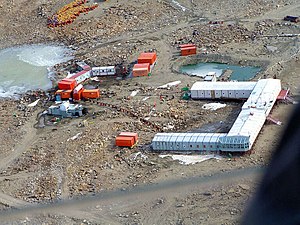Maitri | |
|---|---|
 An aerial view of the Indian Station Maitri, Antarctica on 2 February 2005 | |
Location of Maitri in Antarctica | |
| Coordinates: 70°46′00″S 11°43′55″E / 70.766667°S 11.731944°E | |
| Country | |
| Location in Antarctica | Queen Maud Land Antarctica |
| Administered by | National Centre for Polar and Ocean Research |
| Established | January 1989 |
| Elevation | 117 m (384 ft) |
| Population (2017)[1] | |
| • Summer | 45 |
| • Winter | 25 |
| UN/LOCODE | AQ MTR |
| Type | All-year round |
| Period | Annual |
| Status | Operational |
| Activities | List
|
| Website | ncpor |

Maitri also known as Friendship Research Centre, is India's second permanent research station in Antarctica as part of the Indian Antarctic Programme. The name was suggested by then-Prime Minister Indira Gandhi. Work on the station was first started by the Indian Antartic expedition which arrived the end of December 1984, with a team led by Dr. B. B. Bhattacharya. Squadron Leader D. P. Joshi, the surgeon of the team, was the first camp commander of the tentage at camp Maitri. The first huts were started by the IV Antarctica Expedition and completed in 1989, shortly before the first station, Dakshin Gangotri, was buried in ice and abandoned in 1990–91.[2] Maitri is situated in the rocky mountainous region called Schirmacher Oasis. It is only 5 kilometres (3.1 mi) away from the Russian Novolazarevskaya Station.
India is planning to replace Maitri research station by a new Maitri-2 station by 2029.[3]
- ^ a b Antarctic Station Catalogue (PDF) (catalogue). Council of Managers of National Antarctic Programs. August 2017. p. 85. ISBN 978-0-473-40409-3. Archived (PDF) from the original on 22 October 2022. Retrieved 16 January 2023.
- ^ "Maitri". Polar Conservation Organisation. 11 January 2011. Archived from the original on 30 May 2012. Retrieved 13 April 2009.
- ^ "India to replace 'very old' Maitri research station in Antarctica by 2029". WION. Retrieved 25 December 2023.
